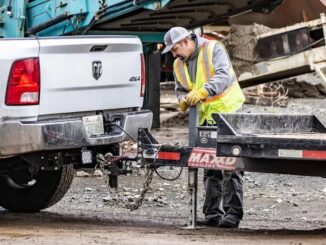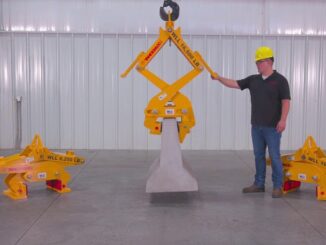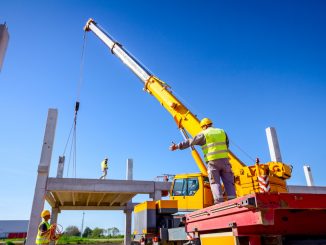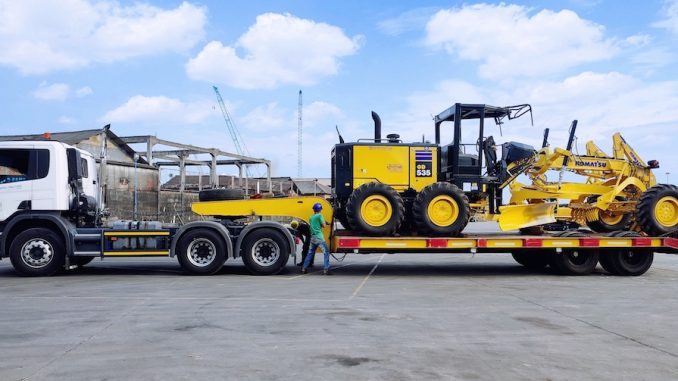
View the complete article here.
Transporting heavy construction equipment is a task that intertwines precision, safety, and regulatory compliance into a complex logistical endeavor. As projects expand and machinery becomes increasingly sophisticated, the demand for professional hauling services has risen significantly. Often, the decision to hire professional haulers is not only recommended but necessary, given the potential risks and liabilities involved. These professionals are equipped with the expertise, appropriate vehicles, and knowledge of legalities—ensuring the machinery reaches its destination securely and efficiently. From the careful assessment of equipment dimensions for transport selection to the nuances of load securing and navigating, this complete guide to hauling heavy equipment provides a roadmap for navigating the logistical challenges faced in heavy equipment transportation.
Pre-Hauling Planning
Before the wheels start rolling, comprehensive pre-hauling planning is essential to ensure the safe and timely transportation of heavy construction equipment.
Assessing Equipment Dimensions and Weight for Proper Transport Selection
Knowing the exact dimensions and weight of the equipment to be transported is the first step in selecting the appropriate trailer and vehicle. This not only affects which transport method to use but also determines the type of permits required and the route that will be taken. Oversized or overweight loads may require special transportation solutions, like modular trailers or multiple vehicles.
Legal Considerations: Permits, Weight Restrictions, and Route Planning
Securing the right permits is a critical legal step in hauling heavy equipment. Permits vary by state and locality and depend on the load’s size, weight, and the route. Weight restrictions must be observed to avoid penalties and infrastructure damage. Route planning is equally crucial to identify roads that can handle the load and to avoid potential obstacles such as low bridges, narrow roads, or construction zones.
Importance of Scheduling and Coordination with Project Timelines
Coordination with project timelines ensures that the equipment arrives exactly when it’s needed, avoiding costly downtime or delays. This involves clear communication between all parties: the hauling team, project managers, and site operators. In addition, haulers need to account for potential delays such as weather conditions, traffic, and road restrictions—planning the schedule with buffer time accordingly.
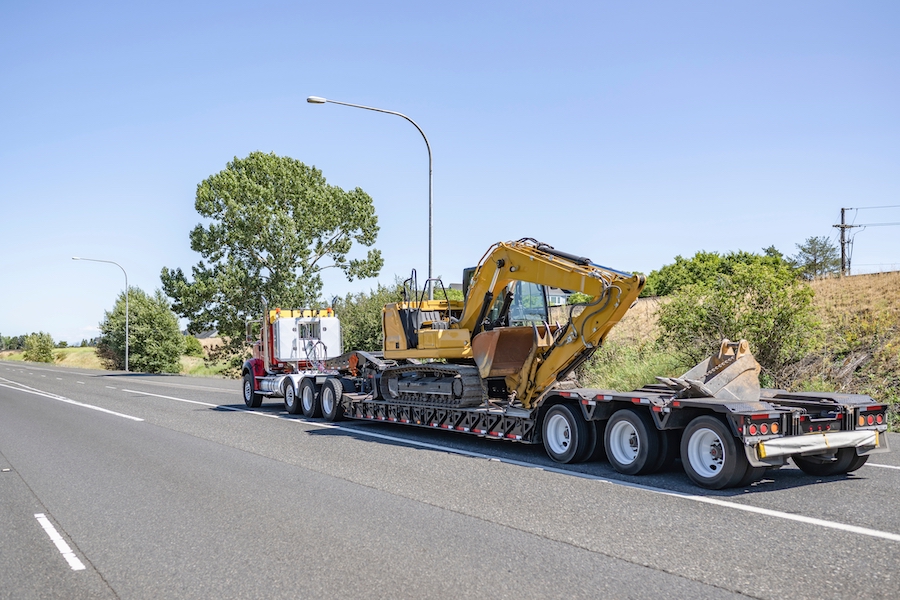
Selection of the Right Transport Vehicle
The safe and efficient transport of heavy equipment hinges on selecting the appropriate vehicle for the job. This choice is dictated by a combination of factors, including the characteristics of the load and the conditions of the journey.
Overview of Transport Vehicles
- Flatbeds: The most versatile type of transport vehicles, suitable for a wide range of equipment. They are open, which allows for easy loading and unloading but provides no protection from the elements.
- Lowboys: These trailers sit very low to the ground, making them ideal for hauling tall equipment or machinery that would exceed height limits on a flatbed.
- Drop decks: Also known as step-deck trailers, they have a lowered deck to accommodate taller loads—offering a middle ground between flatbeds and lowboys.
Factors Influencing the Choice of Trailer
- Terrain: The terrain of the route affects trailer selection. For rough terrain, trailers with higher ground clearance or specialized suspension systems may be required.
- Distance: Long-distance hauls might require different features for driver comfort and efficiency, such as sleepers and fuel economy considerations.
- Equipment size/type: The dimensions and weight of the equipment are perhaps the most critical factors. Overweight or over-dimensional equipment often requires special trailers, like multi-axle or extendable trailers.
Customized Hauling Solutions for Oversized or Irregular Equipment
When standard trailers can’t accommodate a load due to its size or shape, customized solutions become necessary. This might include using modular trailers that can be adjusted for different loads or combining various types of trailers. Specialized transport may also involve additional equipment like dollies or jeeps to distribute weight more evenly and comply with road regulations.
Safety Preparations and Loading
When it comes to hauling heavy construction equipment, safety is paramount. Proper preparations and adherence to safety guidelines can prevent accidents and equipment damage during transportation.
Safety Checks and Preparations
Before loading, a thorough inspection of the transport vehicle is essential. Check the integrity of the trailer’s frame, deck, and tires to ensure they’re in good condition and suitable for the weight class of the heavy equipment. In addition, all load-securing equipment—such as chains, straps, and binders—must be inspected for wear and damage to guarantee they can secure the load safely.
Load Distribution Principles for Stability During Transport
Understanding and applying load distribution principles are critical to maintaining the vehicle’s stability. The weight should be evenly distributed across the axles to avoid overloading any single point, which could lead to tire blowouts or loss of control. The center of gravity should be as low as possible and centered between the axles to reduce the risk of tipping.
Step-by-Step Guide to Loading Heavy Equipment onto Trailers
- Preparation: Clear the loading area of obstacles and ensure that the ground is level and firm.
- Alignment: Position the trailer so that it aligns with the equipment’s path and secure it from moving.
- Loading: Slowly drive or winch the equipment onto the trailer, watching for any shift in balance or alignment issues. If using ramps, verify they are rated for the equipment’s weight and securely attached to the trailer.
- Positioning: Once the equipment is on the trailer, position it according to the load distribution plan.
- Securing: Use the appropriate number and type of restraints to secure the equipment to the trailer. This should be done following manufacturer guidelines and legal requirements.
- Final checks: Perform a final inspection to ensure that everything is secure and that the vehicle’s lights and indicators are functioning properly.
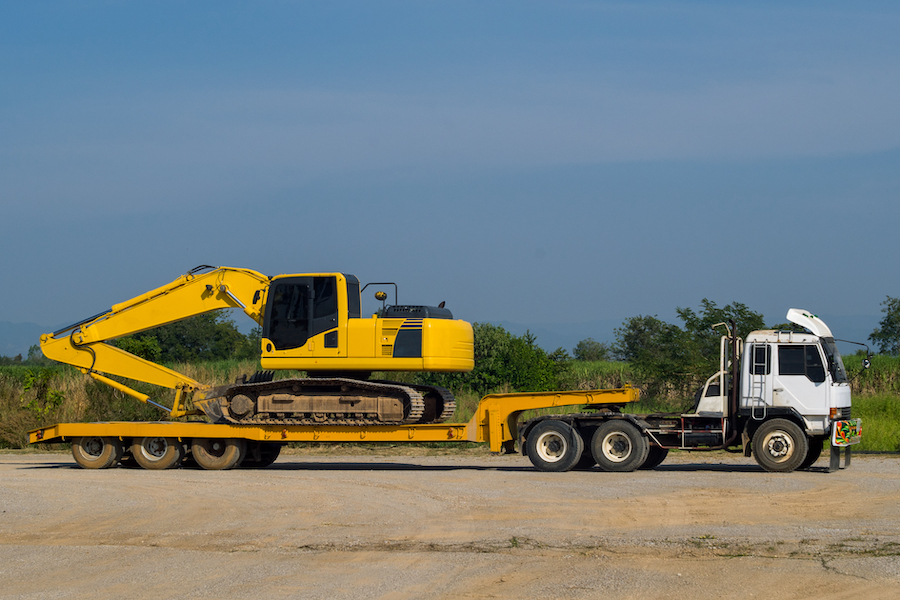
Securing the Load
Once heavy equipment is loaded onto the trailer, it must be properly secured to ensure it remains stationary during transport. The security of the load is not only a matter of safety but also a legal requirement.
Detailed Breakdown of Securing Techniques
- Chaining: Chains are commonly used for their strength and durability. Equipment should have designated chaining points for secure attachment. Binders are then used to tighten the chains and prevent any movement.
- Strapping: Heavy-duty straps can be an alternative to chains for lighter equipment or machinery that might be damaged by the rigidity of chains. Straps should be tensioned with ratchets to ensure a snug fit.
- Blocking and bracing: Wooden or metal blocks should be placed in front of and behind the wheels, and along the sides of the equipment to prevent rolling or shifting. Bracing can also be used within the equipment to keep parts from moving.
Legal Requirements for Load Securing
Each state may have different regulations regarding the number, size, and type of restraints based on the weight and size of the load. The Department of Transportation (DOT) provides federal guidelines that must be followed, which specify how the load should be tied down and the minimum strength requirements for securing devices.
How to Inspect and Ensure the Load is Secure Before Departure
Before setting off, a comprehensive check is necessary:
- Visual inspection: Look for any obvious signs of loose chains, straps, or shifting of the load.
- Tug test: Gently tug on the chains or straps to feel for any give or looseness.
- Double-check securement points: Ensure that all securement points are intact and have not been compromised.
- Check tension: Make sure all chains and straps remain tensioned properly as they can loosen when the load settles.
- Inspect blocking and bracing: Ensure that all blocks and braces are in place and have not shifted during the loading process.
A final walk-around should be conducted to confirm that the load is secure. It’s essential to recheck the load shortly after beginning the journey and periodically throughout the trip, as straps and chains can loosen over time due to the vibrations of travel.
Navigating on the Road
The transport phase is where the rubber meets the road, quite literally. Having qualified drivers and understanding the unique challenges of heavy haulage is key to a successful transport operation.
Driver Qualifications and Training for Hauling Heavy Equipment
Operators of heavy haulage vehicles are required to have a commercial driver’s license (CDL) with specific endorsements related to the types of loads being carried. Additional training is often required to handle oversized loads, which can include safety courses and hands-on training with experienced drivers. This ensures drivers are proficient in vehicle inspection, load securing, and emergency response procedures.
The Challenges of Navigating Heavy Loads
Heavy loads present unique challenges on the road:
- Turning: Larger turning radii are required for heavy haul vehicles, especially when transporting long or wide loads. Drivers must be skilled at judging distances and navigating turns to avoid accidents or damage.
- Reversing: This maneuver requires particular skill when hauling heavy equipment due to the increased risk of jackknifing. It should be avoided whenever possible, but if necessary, it’s often best done with a spotter providing guidance.
- Managing speed: Maintaining a safe and legal speed is critical, particularly under varying road conditions. Heavy loads can dramatically affect braking distances and vehicle handling, so speed must be managed carefully.
Communication and Safety Protocols While in Transit
Staying in communication with dispatch, road authorities, and escort vehicles (if used) is vital. This helps manage any changes in route, traffic conditions, or emergencies. Drivers should have a clear understanding of safety protocols—which include proper signaling for turns and lane changes, use of warning lights, and emergency contact procedures.
Offloading and Post-Transport Inspection
The final phase in the transportation of heavy equipment involves the careful unloading of machinery and an inspection to ensure it arrives in the same condition as it left.
Procedures for Safe and Effective Offloading at the Destination
- Preparation: Just as with loading, ensure that the offloading area is clear and level. Check for overhead obstructions and ensure the ground can support the weight of the equipment and the unloading machinery.
- Method: Use appropriate ramps or lifting equipment that can safely handle the weight of the load. Position the trailer and the offloading equipment correctly to ensure a smooth transition from the trailer to the ground.
- Execution: Operate slowly and communicate clearly with any spotters or assistants. Follow the reverse order of loading, releasing any restraints carefully to maintain stability until the equipment is ready to move.
Post-Transport Equipment Checks to Ensure No Damage Occurred During Transit
Once offloaded, conduct a thorough inspection of the equipment. Look for any signs of damage that might have occurred during transit—such as dents, scratches, or structural deformities. Check that all operational functions are working correctly—including hydraulics, electrical systems, and moving parts.
Documentation and Reporting Procedures for Haul Completion
Documenting the condition of the equipment immediately upon arrival is crucial. Take photos or videos if possible. Any damage should be noted and reported according to company procedures or contractual agreements. The driver should complete all necessary reports for the haul, including the time of delivery and the state of the equipment on arrival, to close out the job officially.
Insurance and Liability
When transporting heavy equipment, understanding and managing the associated risks is crucial for protecting financial interests and complying with legal requirements.
Understanding Insurance Coverage for Transport Risks
Transporting heavy equipment comes with inherent risks such as accidents, damage to the equipment, or third-party property damage. Insurance coverage is essential to safeguard against these risks. Coverage options can include cargo insurance, liability insurance, and in-transit coverage. It’s important to understand the terms and limits of the insurance policy to ensure that it meets the value of the equipment and the potential risks involved.
Mitigating Liability: Contracts, Insurance, and Transporter’s Responsibility
- Contracts: These should clearly outline the responsibilities of all parties involved—including the conditions of transport, delivery expectations, and what constitutes a breach of contract.
- Insurance: Both the hauling company and the equipment owner should have insurance coverage. The transporter’s insurance typically includes liability for damage caused during transport, while the equipment owner’s insurance might cover the equipment’s value in case of loss.
- Transporter’s responsibility: Transporters must comply with industry regulations and safety standards to mitigate liability. This includes proper equipment maintenance, adhering to weight and size regulations, and ensuring drivers are adequately trained.
Thorough documentation and clear communication are key in mitigating liability. Proper risk management through insurance and adherence to contractual obligations provide financial protection and peace of mind during the transportation of heavy machinery.
Final Thoughts
The transportation of heavy construction equipment can be a complex process that demands attention to detail and adherence to best practices. Meticulous planning, from selecting the right transport vehicle to securing the load correctly and navigating the transport safely, is critical to ensure the equipment arrives in perfect condition and ready for use.
Given the complexities and liabilities associated with hauling heavy equipment, it’s often recommended to enlist the services of professional transportation companies. These specialists have the experience, equipment, and knowledge of regulations to handle the task effectively—minimizing risks and ensuring that the job is done right. By leveraging the expertise of professionals, companies can focus on their core operations—confident that their equipment is in safe hands. Whether choosing to handle transportation in-house or outsourcing to professionals, the key to success lies in never cutting corners and always striving for the highest safety standards.
View the complete article here.
What permits are needed for transporting heavy equipment?
Permits vary by state and locality, depending on the load’s size, weight, and the route.
How should heavy equipment be secured during transport?
Equipment should be secured using chains, straps, and blocking/bracing, following legal and manufacturer guidelines.






































